« Features
Takin’ It To The Streets. An Interview With Susan Silton
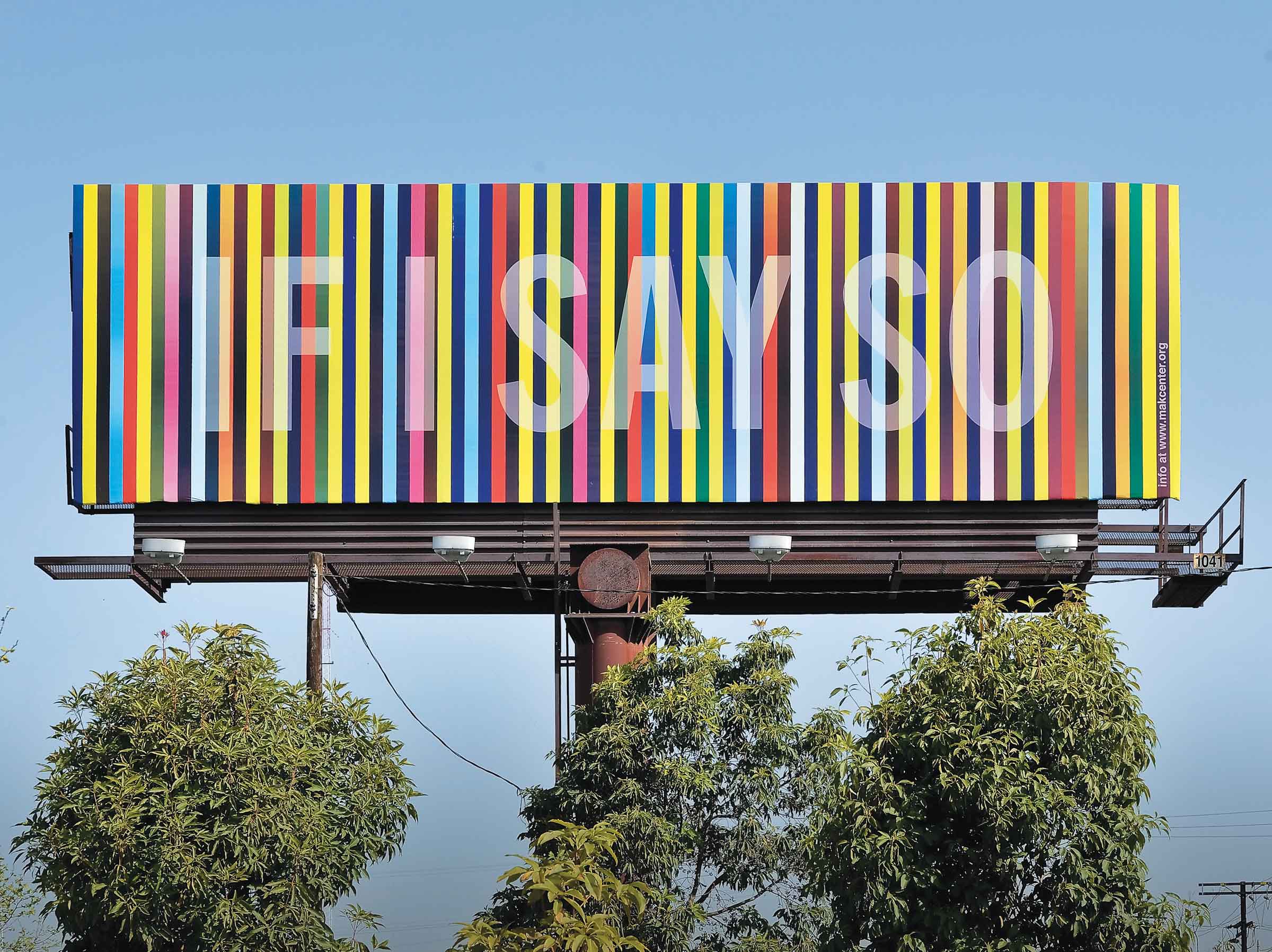
Susan Silton, If I Say So, 2010, Billboard commission, MAK Center for Art and Architecture, as part of the exhibition, “How Many Billboards? Art in Stead.” Photo: Gerard Smulevich
Susan Silton’s art sneaks up on you where you least expect it, often in public, on power boxes, billboards and fumigation tents, in postcards and posters, in whistling crowds and on Facebook. Silton’s work is all about communication (and lack thereof) and power (and lack thereof). Silton has cultivated a thriving practice with her multimedia works interrogating the history of stripes as signs for social deviance, her postcards re-situating the language of wartime propaganda leaflet drops, and a recent project citing quotes about free speech in public spaces. She was happy to share her thoughts in this interview, in which we discuss her ongoing projects, the Occupy Wall Street movement, art, politics and the power of words.
By Tucker Neel
Tucker Neel - Your work often resides in public places or is framed by a public experience. What is it about public space that interests you? What sort of considerations do you make when negotiating work for a public space?
Susan Silton - I’m especially interested in the accessibility of public space-how it can expand the audience for a given work and provides a viable art platform beyond the commodity-based value structure of the institutional white cube. Last year, for example, I participated in an event called Trespass Parade, which was a celebration of free speech mounted by Los Angeles-based nonprofit organization West of Rome. As part of the parade, I passed out a series of postcards I produced in conjunction with a concurrent public project of mine about free speech called Utility, which is installed on five utility boxes in neighboring Pasadena. It’s incredibly gratifying to extend a work’s sphere of influence beyond the gallery or museum. If one person who never sets foot in a traditional art space posts one of my postcards on her/his refrigerator, the work, to my mind, has achieved great success. And this is in sharp contrast to how success is defined by the institutional art world. In addition to the accessibility of public space, I’m drawn to the relationship between public space and media proliferation; public space is where and how media of every conceivable nature goes viral. As such, it’s propaganda’s chief venue. So I regard the public realm as a rich site for subversive intervention.
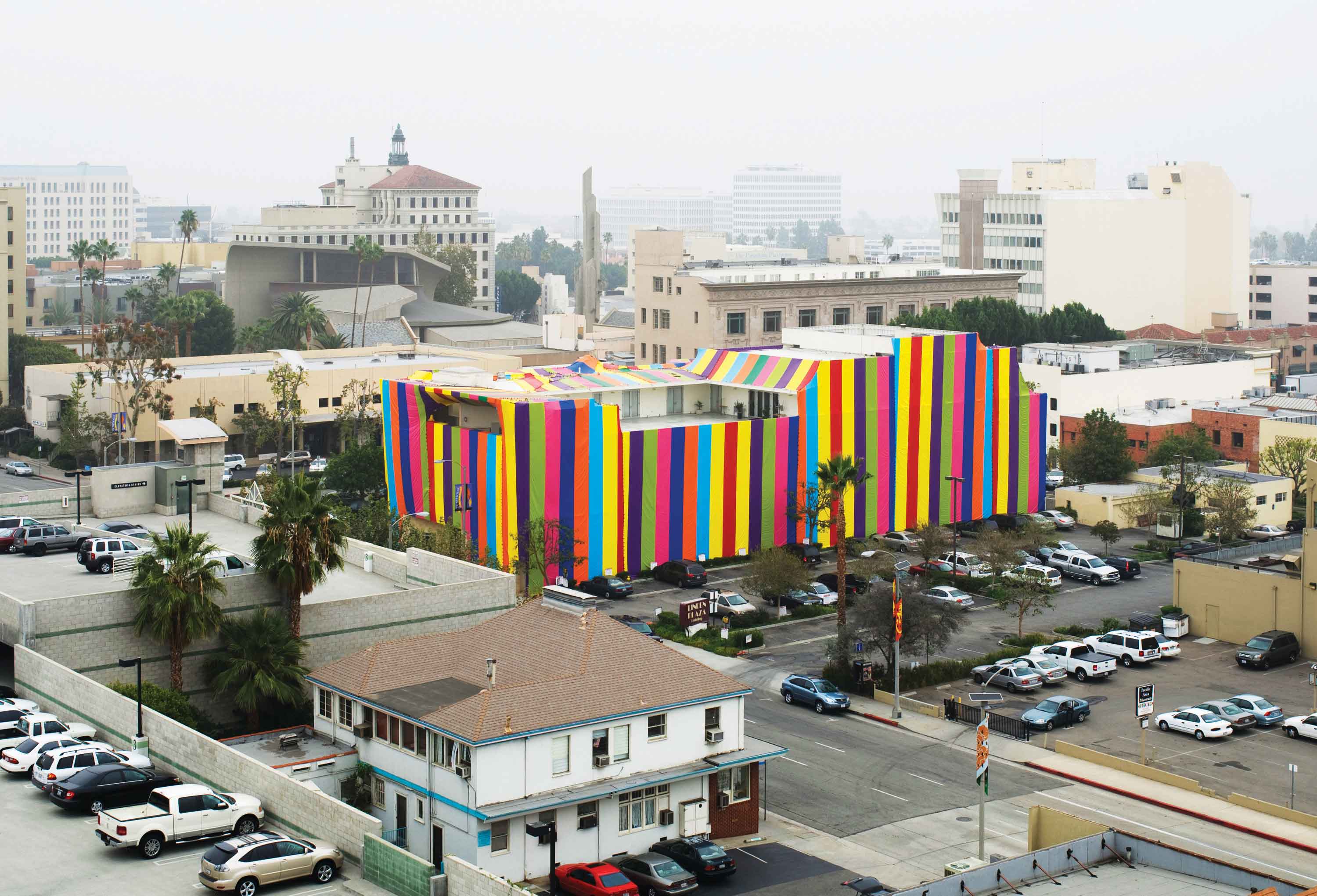
Inside Out, 2007, site-specific installation at Pasadena Museum of California Art, vinyl tarps, sandbags, pony clips. Photo: Robert Wedemeyer
T.N. - You make a lot of work that takes ‘political issues’ as its subject. I‘m thinking here of your recent work in Pasadena addressing censorship or your propaganda postcards. How do you see your art practice in relation to politics, specifically activism? I mention activism because your work often uses direct texts to communicate specific messages to the viewer, perhaps to inspire some sort of action?
S.S. - I don’t regard any of my artistic output as being an overt call to action, but of course it’s politically infused. Art production is the form of activism I most comfortably inhabit. Neither of the projects you mentioned are intended to inspire action so much as to engage reflection about its broader context and meaning, calling to mind the famous Hannah Arendt quote about storytelling revealing ”meaning without committing the error of defining it.” Reflection itself, on the part of the spectator, is extremely active. If I’m lucky, this is what my work will provoke.
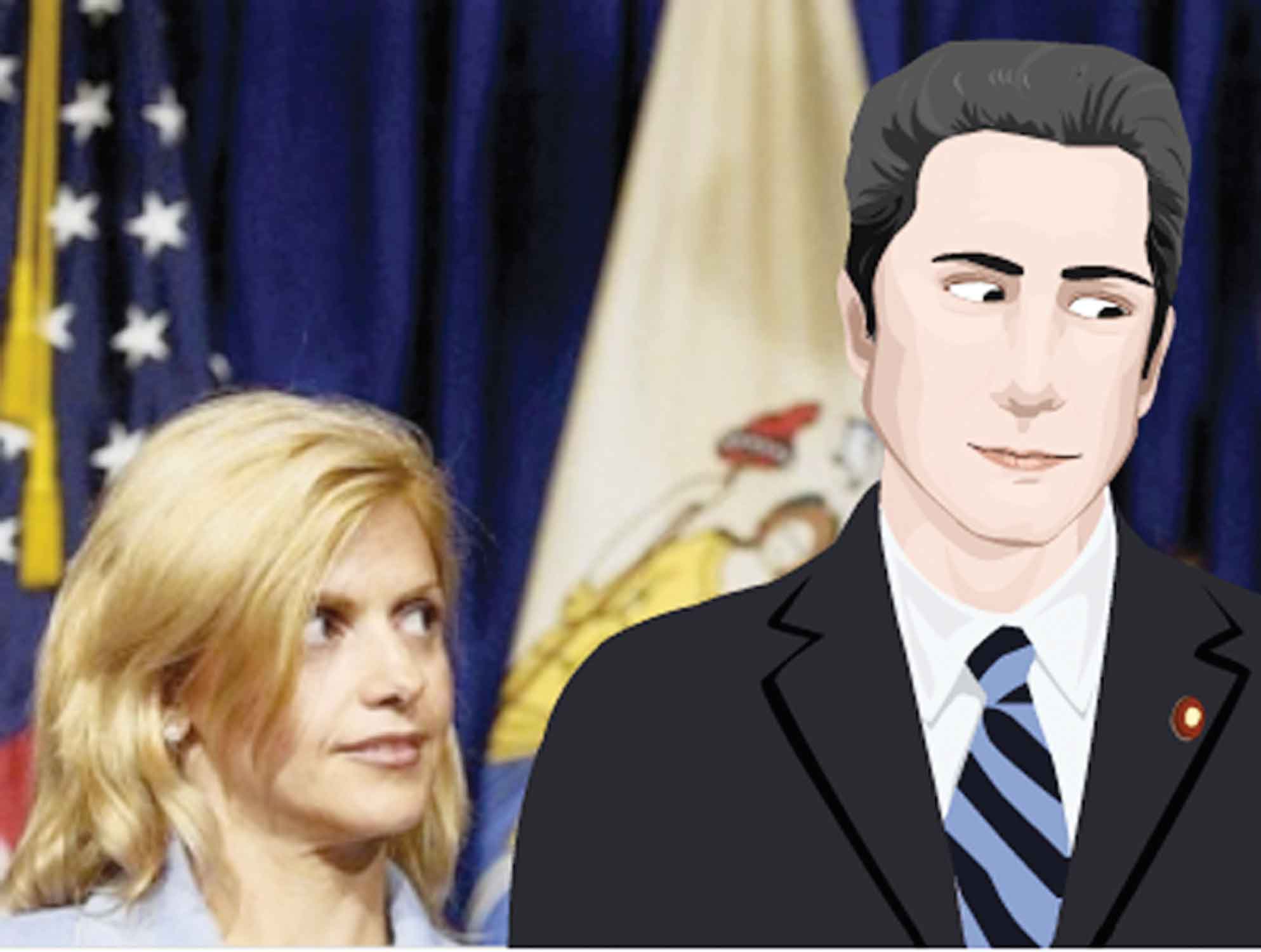
JAMES, from the series BY THE CROWD THEY HAVE BEEN BROKEN; BY THE CROWD THEY SHALL BE HEALED, 2009. Animated video.
As you note, language is often incorporated into my practice, sometimes in more literal ways, as in the Pasadena utility box project, but most often in more coded ways, as with the propaganda postcards. Language is equally as pervasive as image, and just as weighted, if not more so, with signification. So I’m most interested in interrupting the channels through which language, and its concomitant spin, is conveyed, and received.
T.N. - On a similar note as the previous question, what role do you see art, particularly your art, playing with regards to political change. I ask this because a few months ago we discussed the Occupy Wall Street movement and our shared desire to do something. Have the grassroots movements of OWS inspired you to make new work?
S.S. - At the inception of OWS and throughout its many occupations, I was energized by the activity I witnessed (and continue to observe in reverberative actions), but for me this hasn’t yet translated into work directly related to the movement. Many of us as you know saw work being generated site specifically by friends, including actions, performances, discussions. Artists have always been on the front lines of political change, but this movement is still in its nascency, as are the creative works emerging from it. I’m following the discourse on a regular basis, but I’m not in the thick of it as other artist friends are. When I went down to Occupy L.A., though, I was so struck by the vibration of the place; there was an overwhelming sense of shared hope even amidst the crankiness that comes from recognizing and resisting difference. I’m currently working on projects that are still in process or were put on hold last year for health reasons. These include a book/exhibition project that originally was an intervention in a John Baldessari public piece; a new whistling project in the Canary Islands for which I was recently awarded funds by Art Matters Foundation and Center for Cultural Innovation to help realize; and a new project that I’m conceiving about my recently scarred body.
T.N. - Your work, BY THE CROWD THEY HAVE BEEN BROKEN; BY THE CROWD THEY SHALL BE HEALED <http://www.facebook.com/event.php?eid=130960708760&ref=ts> (2009) involved digital avatars of publicly disgraced men, like Mel Gibson or Bill Clinton, performing an apology, but with your voice substituted for theirs. The entire work was ‘exhibited’ on Facebook, a very public virtual space. I‘m wondering what your thoughts are about social networks, specifically Facebook and its perennial problems with privacy issues, since you made this project?
S.S. - I conceived the work for Facebook because of my ambivalence about social networking and the strange hybridity between public and private space that is now the new normal. The public apology for private indiscretions has also become a normalized form of discourse, so I felt it was the perfect content for the Facebook platform. As for privacy issues, I think it’s naive to have thought from the moment Facebook and other social networks originated that there wouldn’t be privacy issues. Facebook is a corporation, and as users each one of us is one of its consumers, consuming each other. Don’t get me wrong, I absolutely love Facebook as a platform for collective protest, information sharing and even art production; this is when it feels the most authentic and transformative.
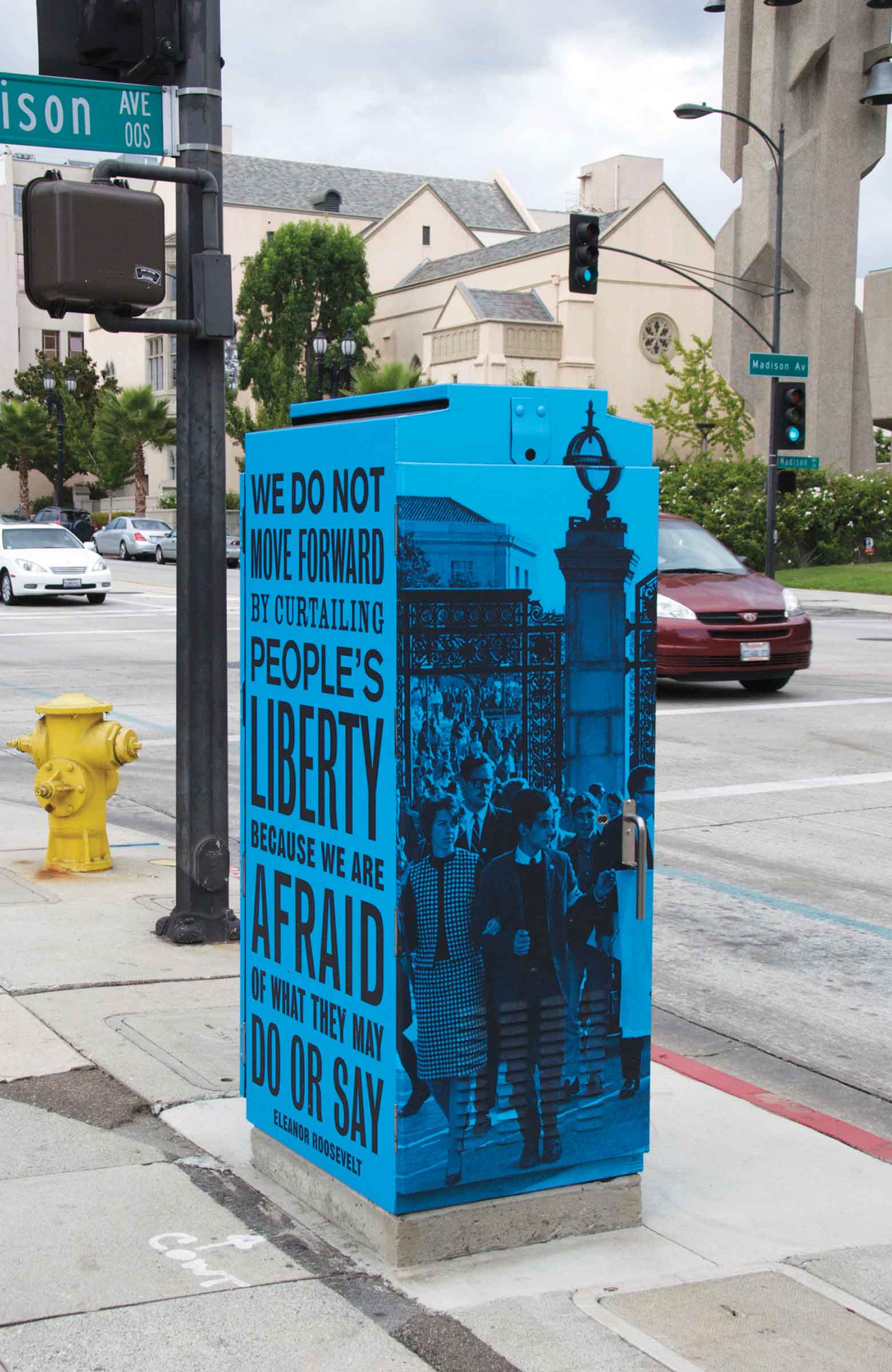
Utility, 2011, vinyl wraps, five utility boxes. Public art commission by Pasadena Playhouse District, Pasadena, CA.
T.N. - You had installed fumigation tarps (that might refer to Daniel Buren or Christo) covering art institutions such as the Pasadena Museum of California Art. Are these tents a critique of art institutions? Are they a comment that something might be rotten inside art institutions, the art market, the art system?
S.S. - Yes, absolutely, that’s an unequivocal and intentional reading of the work. But the museum wrap at PMCA is part of an ongoing, more extensive investigation of the stripe. I had been commissioned in 2004 to produce a billboard to coincide with the election of that year. We had just invaded Iraq the year before, and George Bush and company were at the height of egregious policy making. I used an image I’d taken some years prior of a fumigated house covered in red, white and blue stripes, which became a trenchant metaphor for the diseased country. This led to a deeper inquiry into the stripe; beyond its more obvious associations with modernism, the stripe has a compelling history as a signifier for otherness, as put forward by social historian Michel Pastoureau in his book The Devil‘s Cloth: A History of Stripes. Pastoureau traces the stripe, in clothing, to the Middle Ages, when it was being worn by society’s outcasts in one form or another. So this historical framing of the stripe as abject added a new dimension to present-day fumigation tents. There is an insistence of content in the stripes wrapping the PMCA, which is how it distinguishes itself from, say, Buren’s use of the stripe, or Christo’s wraps.
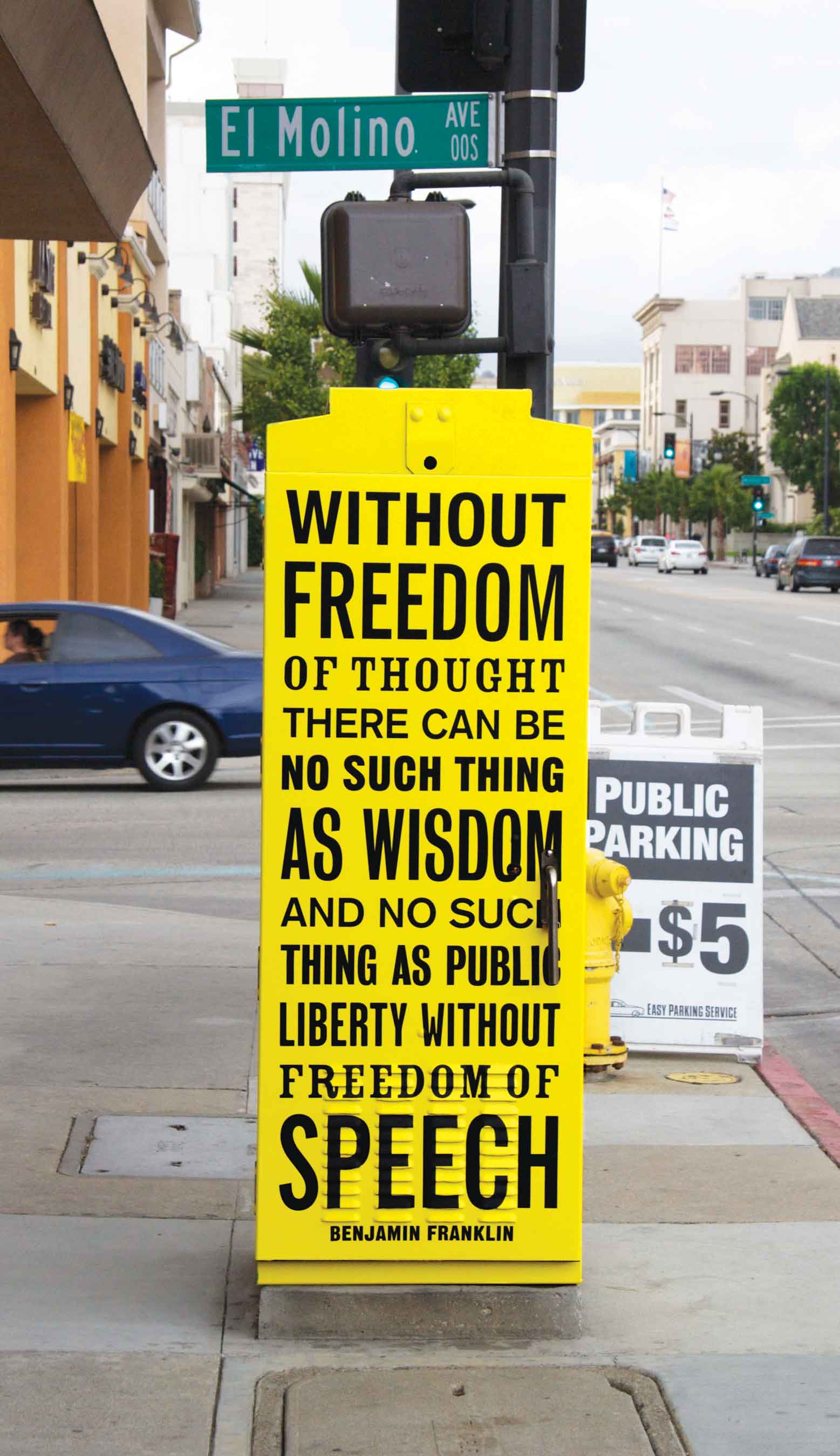
Utility, 2011, vinyl wraps, five utility boxes. Public art commission by Pasadena Playhouse District, Pasadena, CA.
T.N. - I‘ve been thinking recently about all the handmade protest signs that came out of the Occupy Wall Street protests. I‘m just wondering if there are any specific signs that caught your attention?
S.S. - So many I can’t cite them all here! The pervasiveness and immediacy of media has much to do, I’m sure, with how prevalent the protest signage became. Plus it’s such a succinct populist expression of the individual and collective voice. But I think the astute wordplay in many of those that circulated reveals just how strong a role language has increasingly played in the production and dissemination of spin by both corporate and government entities and how this is now being reflected back in various ways in protest signage. It seems like an interesting kind of acculturation.
The sign held by Cornel West that went viral will likely persist as an iconic image of OWS: ‘IF ONLY THE WAR ON POVERTY WAS A REAL WAR THEN WE WOULD ACTUALLY BE PUTTING MONEY INTO IT.’ But there were other brilliant combinations of wordplay and seriousness, like ‘ONE DAY THE POOR WILL HAVE NOTHING LEFT TO EAT BUT THE RICH.’ Another iconic sign, for obvious reasons, came from an American soldier: ‘2ND TIME I’VE FOUGHT FOR MY COUNTRY 1ST TIME I’VE KNOWN MY ENEMY.’ As an aside, I read some months ago that the Smithsonian had made a concerted effort to collect protest signs, including those from Tea Party protests, for its collection. Let’s see what happens if and when they show up on the walls of that institution.


































